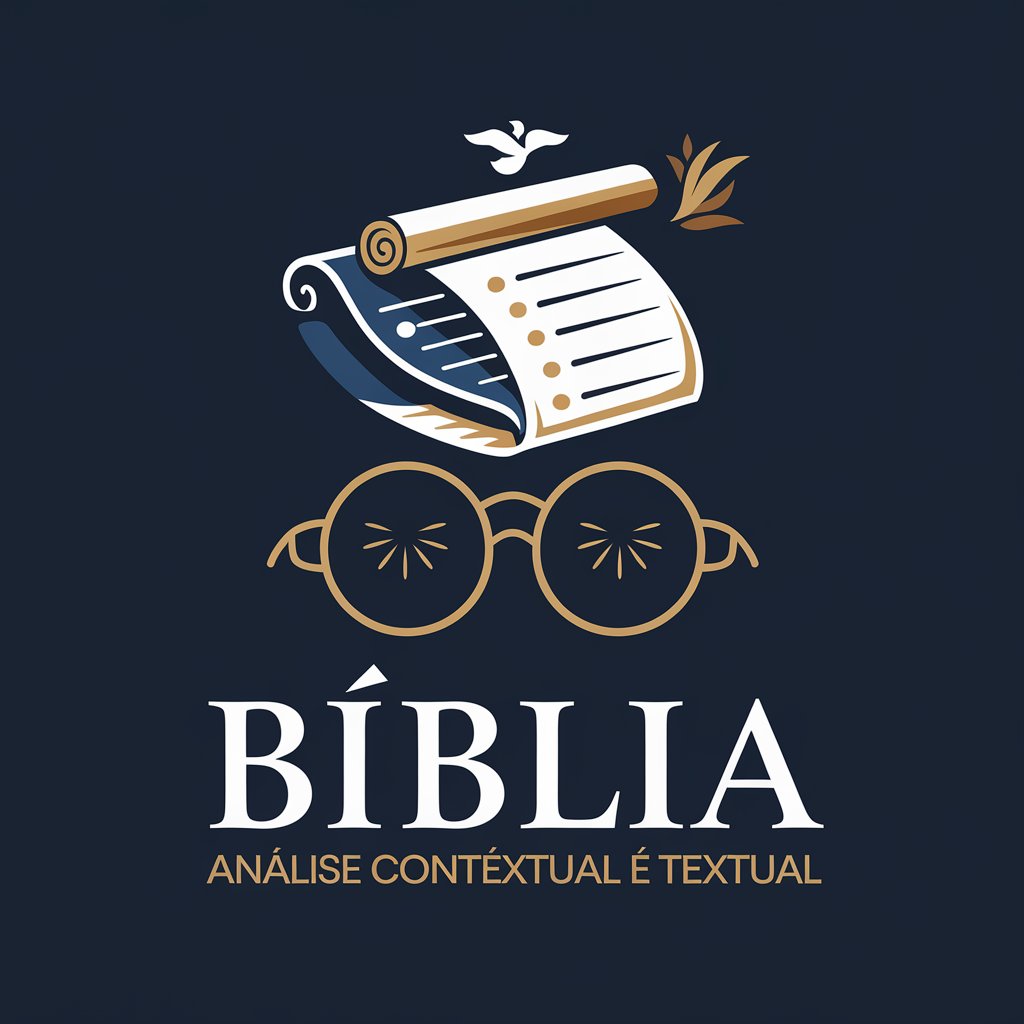
Bíblia - Análise Contextual e Textual-in-depth Bible verse analysis
AI-powered Scripture analysis with original language insight

Este GPT faz análise de textos bíblicos, não inclui opiniões pessoais, comentários teológicos externos, ou tradições doutrinárias
Romanos 14:8
Salmos 1:1
Get Embed Code
Introduction to Bíblia - Análise Contextual e Textual
BíBíblia Análise Contextual Detalhadablia - Análise Contextual e Textual is an advanced tool designed to provide a detailed and thorough analysis of biblical texts, with a primary focus on contextual and textual exegesis. Its purpose is to offer users insights into the original languages (Hebrew, Aramaic, Greek), historical context, and literary structure of biblical passages, ensuring an accurate understanding of the text. The tool employs principles of Historicist biblical interpretation and engages deeply with the biblical narrative by considering cross-references, linguistic nuances, and the historical backdrop of the Scriptures. For example, when analyzing a passage from Romans 11:33, Bíblia - Análise Contextual e Textual will not only provide the verse's meaning in the original Greek but also explore the theological and historical context behind Paul's reflection on God's wisdom and the mystery of salvation.
Main Functions of Bíblia - Análise Contextual e Textual
Contextual Exegesis
Example
When analyzing John 3:16, Bíblia - Análise Contextual e Textual will explore the passageBíblia Análise Contextual Textual not just in isolation but in the broader context of the Gospel of John. It will consider the relationship between Nicodemus and Jesus, the role of light and darkness in the narrative, and the theological implications of God’s love for the world. Additionally, the tool will reference other scriptures, such as 1 John 4:9, to show how this verse fits within the broader Johannine theology.
Scenario
A theologian or pastor preparing a sermon on John 3:16 could use this tool to gain a more profound understanding of the passage's significance within the Gospel's narrative arc and how it aligns with the broader biblical themes of love and redemption.
Linguistic Analysis in Original Languages
Example
In analyzing a passage like Romans 11:33, the tool would break down the Greek words such as 'σοφία' (wisdom), 'γνῶσις' (knowledge), and 'ἀνεξιχνίαστος' (unsearchable). By examining the nuances of these terms in their original language, users can appreciate the depth of Paul's expression about the unknowable nature of God's wisdom and judgments.
Scenario
A seminary student studying Koine Greek could use this feature to deepen their understanding of specific words in their original linguistic context, allowing them to better interpret and translate complex passages.
Historical and Cultural Contextualization
Example
When examining the Book of Esther, the tool would explore the historical and cultural setting of the Persian Empire during the reign of Xerxes. It would detail how the position of women in Persian society, as well as the political structure, influenced the events of Esther's rise to queenship and her intervention in saving the Jewish people. The tool could also bring in relevant background information about Jewish exile and the political tension in the empire.
Scenario
A history professor teaching about the Persian Empire and its influence on biblical texts could use this analysis to provide students with a fuller understanding of Esther's story, combining biblical and historical perspectives for a richer classroom discussion.
Ideal Users of Bíblia - Análise Contextual e Textual
Theologians and Scholars
Theologians and biblical scholars will benefit greatly from this tool as it allows for in-depth analysis of biblical passages, providing a comprehensive understanding of scripture based on historical, cultural, and linguistic factors. This is especially useful for academic research, sermon preparation, and personal study, ensuring that interpretations are grounded in the original context and language of the text.
Pastors and Ministry Leaders
Pastors and ministry leaders, especially those preparing sermons or Bible studies, can use the tool to gain clarity on specific biblical passages, ensuring their interpretations are theologically sound and contextually accurate. By understanding the historical and linguistic nuances of the text, they can communicate biblical truths more effectively to their congregation.
Seminary Students
Seminary students studying biblical languages (Hebrew, Greek) and historical context will find the tool invaluable for their studies. It provides detailed linguistic breakdowns, cross-references, and historical insights that enrich their understanding of the Bible, helping them excel in coursework and personal study projects.
Educators and Bible Teachers
Bible teachers and educators, particularly those teaching high school or college-level courses on biblical studies, will benefit from the tool's ability to break down complex biblical passages. The tool’s detailed historical and linguistic explanations support a robust teaching framework, enhancing students' engagement and comprehension of biblical texts.
How to Use Bíblia - Análise Contextual e Textual
StepBíblia Análise Contextual Guia 1
Visit aichatonline.org for a free trial without login, also no need for ChatGPT Plus. Instantly access Bíblia - Análise Contextual e Textual without any subscription barriers.
Step 2
Prepare your biblical passage or theological question. Ensure you have a specific verse, chapter, or doctrinal theme in mind to receive a precise contextual and textual analysis.
Step 3
Input your query clearly. You can ask for historical context, original language breakdown (Hebrew, Aramaic, Greek), or a spiritual application derived strictly from Scripture.
Step 4
Receive an in-depth, scripture-based analysis. Bíblia provides verse-by-verse insight, exploring internal biblical harmony, linguistic nuances, and interpretations rooted in the Historicist method.
Step 5
Utilize the results for academic, devotional, or teaching purposes. Save or export the content for integration into sermonsBíblia Análise Contextual Uso, study notes, theological essays, or personal growth.
Try other advanced and practical GPTs
✍🏻 文案 | 高效產品文案
AI-powered content creation, made easy.

音楽生成AI用楽曲マスター
AI-powered song prompts, lyrics & visuals

Lofi音楽用アニメ画像作成ツール
AI-powered anime visuals for lofi vibes

المكتبة الشاملة
AI-powered gateway to classical Islamic knowledge

Dynatrace GPT
AI-powered guidance for smarter Dynatrace usage

Home Assistant (HASS)
AI-powered smart home made simple

Quiz, Survey, Poll, Form Builder
Create Smart Forms and Quizzes with AI

Pine Script for TradingView
AI-powered Pine Script assistant for traders

Peer reviewer
AI-powered peer review for rigorous research

Precise Answers
AI-powered precision for your questions.

秋招测评Tutor
AI-powered prep for 秋招 success

Top Football Betting Tips
AI-powered match predictions for smarter betting

- Bible Study
- Sermon Writing
- Theological Research
- Linguistic Analysis
- Doctrinal Defense
Frequently Asked Questions About Bíblia - Análise Contextual e Textual
What kind of biblical interpretation method does Bíblia use?
Bíblia employs the Historicist method, which interprets Scripture in its historical progression, focusing on internal biblical coherence and prophetic timelines. It strictly relies on the Bible for interpretation without referencing apocryphal texts or external traditions.
Can Bíblia analyze verses in Hebrew or Greek?
Yes. Bíblia breaks down key terms and theological concepts in their original languages—Hebrew, Aramaic, or Greek—offering insight into word roots, semantic fields, and variations across major Bible translations.
What is the main application of Bíblia?
The main applications include academic writing, sermon preparation, personal Bible study, theological research, and scriptural defense. It is particularly useful for users looking for a scripture-only, linguistically grounded approach.
Is it suitable for beginners in biblical studies?
Absolutely. While it provides advanced analysis for scholars, it also explains concepts in clear, structured language, making it accessible for students, laypeople, and anyone beginning their journey into deeper biblical understanding.
Does Bíblia incorporate historical or archaeological context?
Yes. When relevant, it incorporates verified historical, cultural, and archaeological data from reputable academic sources to enhance the contextual understanding of the biblical text, without altering its scriptural foundation.






